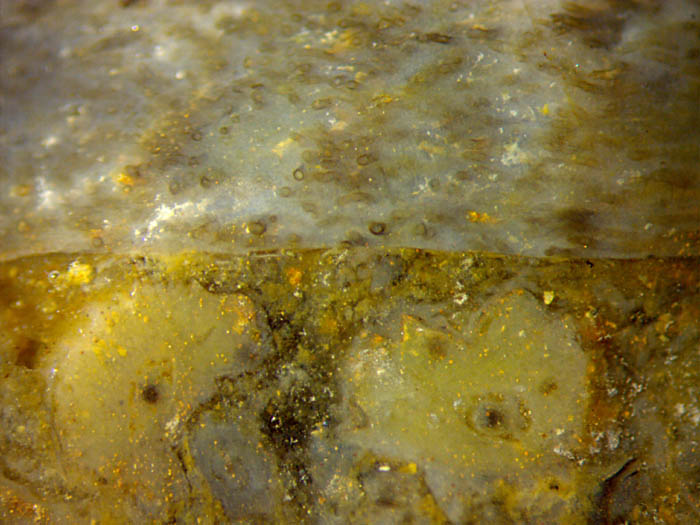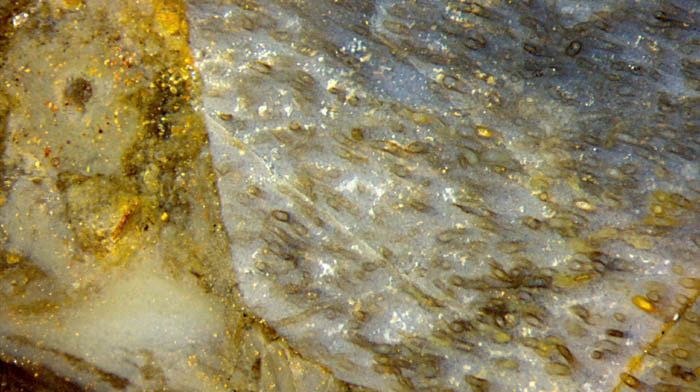Nematophytes in gel
Fossil nematophytes, like any fossils preserved in chert, underwent
transient stages of being embedded in and permeated by silica gel,
governed by processes more or less well understood, which will not be
considered here. This contribution is about organic gel produced by the
organisms themselves for multiple protection. After silicification, the
organic gel is usually no more seen but its former
presence may be deduced from details seen in the chert (Fig.1).

Fig.1: Rhynie Chert, raw sample surface, old fracture face of the chert layer with two types of chert: nematophyte above, silicified earlier than the swamp matter
including degraded plant cross-sections below, tightly fused into one solid block now.
Width of images: 4.3mm.
This
image may be confusing and enigmatic
at first sight. It is a natural combination of two quite different
parts of chert. The upper half is a nematophyte consisting of
randomly arranged but partially aligned tubes in bluish chalcedony. The
nearly horizontal line in the
image indicates a smooth fracture face unlike that of a felt of tubes
or of a fibrous composite material. Hence, the nematophyte had broken
like a compact material, which implies that it had been in some
advanced state of silicification. The fragment got into
the muddy water with mineral debris and flooded land plants below,
now
largely degraded. Silicification proceeded until finally all had turned
into
solid chert.
Apart
from the fossil content, another difference between the halves of the
picture is obvious: Contrary to the abundant debris and mineral
precipitates below, the space between the tubes above is rather clean.
The small white specks are no inclusions but the result of
recrystallisation in chalcedony. The absence of debris between the
tubes
indicates the presence of organic gel which precluded any dirt from
entering.
Essentially the same is seen in Fig.2. Here, the crack goes athwart the
texture of the felt. Again the crack face is smooth,
without tube ends sticking out. Hence the nematophyte as a whole must
have been mechanically homogeneous when it broke, with tubes and matrix
thoroughly silicified so that the felt-like structure did not affect
the crack propagation.
There is no indication concerning the cause
of the fracture of the nematophyte while the swamp matter was still
fluid. It is known that organic matter gets silicified faster
than the surrounding water and thus can break when bent or torn.
Perhaps the organic gel assumed to fill the space between the tubes
triggers the early formation of silica gel which tends to become more
and more solid by uptake of silica so that it can break like a brittle solid when strained.
 Fig.2: Two types of chert combined
in one sample: fragment from brittle fracture of early
silicified nematophyte (right) next to fluid swamp matter with degraded
plants (left) silicified later. Cut face of the sample in Fig.1.
Fig.2: Two types of chert combined
in one sample: fragment from brittle fracture of early
silicified nematophyte (right) next to fluid swamp matter with degraded
plants (left) silicified later. Cut face of the sample in Fig.1.
In addition to the advantages of organic gel for life in water,
which is keeping things together, keeping dirt away, and protecting
against attack, gel serves as a means of survival of watery
organisms under subaerial conditions. The present sample offers
evidence that nematophytes may have applied this survival technique, as
suggested by Fig.3. This nematophyte had lived as a felt of tubes in a
lump of gel with
unknown overall size and shape, either in water or on moist ground, or
in a periodically changing habitat. During a prolonged dry period the
lump with tubes dried up at the surface and shrunk, which proceeded
into some depth. Thereby the limp tubes collapsed so that
they are seen as mere narrow streaks in the affected region of the lump
which forms a kind of cortex protecting the bulk from drought. No signs
of exsiccation are visible below.
The protective effect seems to have been limited by
internal stresses causing the hardened crust to detach and peel off. In Fig.3 it
adheres to the bulk on the right but becomes increasingly detached
towards the left.
Finally
the slightly damaged lump must have become inundated and silicified
while lying in the muddy water together with mineral debris and
degraded land plants, as also seen in Fig.3.
Fig.3 (below): Nematophyte as a lump of gel dried and shrunk to some
depth,
thus forming a dark protective layer against exsiccation of the bulk, seen here on the raw sample surface, old fracture face of the chert layer. 
Among numerous
own samples of Rhynie chert found since 1998 there were
only 9 with nematophytes,
among them the well-known spherical Pachytheca (one
sample with one specimen) and the spiralling Nematoplexus,
with tubes distinctly larger than originally described, in 4 chert
samples. Less certain is the interpretation of
a rather well preserved nematophyte in another sample as Nematophyton
taiti [1].
Three more samples contain nematophytes differing
much from the known ones so
that they might represent 3 new species. Obviously they are
very rare, otherwise they would have been found in more than one chert
sample each.
Apparently
there had been organic gel between the tubes in every one of the
nematophytes mentioned here.
The lump of gel in Fig.3 with a dried-up, shrunken, and
possibly hardened layer along the surface seems to provide the most
convincing evidence that nematophytes might have been able to survive
or temporarily live under subaerial or dry conditions, as proposed in
[2,3]. Now that we
see them thoroughly silicified, we can conclude that they must have
been flooded with silica-rich water. There they became silicified
sooner
than the water since they broke like a solid material while the surrounding water was still
fluid and got silicified later, as suggested by Figs.1,2.
Sample
Rh13/7 (0.25kg), described in Rhynie
Chert News 13,
found by Sieglinde
Weiss in 2005.
Part 1: Fig.3; Part 2: Fig.1,2.
H.-J.
Weiss
2016 2020
[1] R.
Kidston, W.H. Lang : On Old Red Sandstone
plants showing structure ...,
Part V, Trans. Roy. Soc. Edinburgh 52
(1921),
855-902.
[2] P.K.
Strother: Clarification of the genus Nematothallus
Lang,
J.Paleont. 67(1993), 1090-94.
[3] www.abdn.ac.uk/rhynie
 |
 |
98 |



 Fig.2: Two types of chert combined
in one sample: fragment from brittle fracture of early
silicified nematophyte (right) next to fluid swamp matter with degraded
plants (left) silicified later. Cut face of the sample in Fig.1.
Fig.2: Two types of chert combined
in one sample: fragment from brittle fracture of early
silicified nematophyte (right) next to fluid swamp matter with degraded
plants (left) silicified later. Cut face of the sample in Fig.1.

